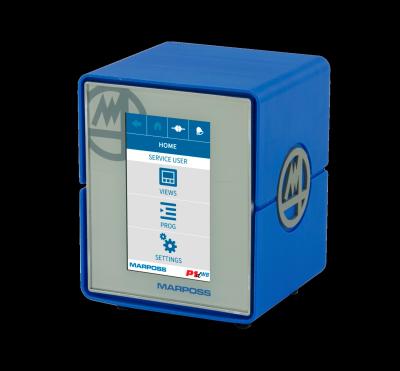
Marposs has announced the availability of its P1dWB, an entry-level grinding wheel balancing and process monitoring system. This new system is intended to replace Marposs’ electronic systems E78 and E82. Designed with full backwards capability, the P1dWB features new functions, such as prebalancing and spectral analysis of the imbalance. The system can also manage a single balancing head and simultaneously an integrated acoustic sensor (if present) both for flange (FT) and spindle (ST) models.
The P1dWB balancing system helps control the intensity of vibrations on the grinding wheel to automatically compensate for imbalance, helping to improve the quality of the parts being ground, specifically their surface finish and geometry. Machining cycle times can also be optimized.
The system is available in three versions: rack, stand-alone and remote panel, so that it can be installed outside of the machine tool or integrated in the operator panel. It has a user-friendly 4.3-in. touchscreen and comes with a tool for data backup, restore operations as well as the ability to act as the HMI if the system is used with a personal computer rather than a panel. Other features available on the P1dWB include a multi-level log-in function for secure management of data and settings, and a self-diagnostic function that quickens troubleshooting.
The Marposs P1dWB is designed to upgrade old-generation, in-process and pre/post-process amplifiers. Replacing an existing Marposs E78 or E82 will enable users to meet international environmental and safety standards, as well as reducing maintenance costs thanks to the new warranty coverage. The P1dWB is ready to install on a grinding machine, with no need to modify the control logic; it is supplied with a dedicated accessories kit that ensures the "plug and play" replacement procedure is simple and quick.
Contact Details
Related Glossary Terms
- grinding
grinding
Machining operation in which material is removed from the workpiece by a powered abrasive wheel, stone, belt, paste, sheet, compound, slurry, etc. Takes various forms: surface grinding (creates flat and/or squared surfaces); cylindrical grinding (for external cylindrical and tapered shapes, fillets, undercuts, etc.); centerless grinding; chamfering; thread and form grinding; tool and cutter grinding; offhand grinding; lapping and polishing (grinding with extremely fine grits to create ultrasmooth surfaces); honing; and disc grinding.
- grinding machine
grinding machine
Powers a grinding wheel or other abrasive tool for the purpose of removing metal and finishing workpieces to close tolerances. Provides smooth, square, parallel and accurate workpiece surfaces. When ultrasmooth surfaces and finishes on the order of microns are required, lapping and honing machines (precision grinders that run abrasives with extremely fine, uniform grits) are used. In its “finishing” role, the grinder is perhaps the most widely used machine tool. Various styles are available: bench and pedestal grinders for sharpening lathe bits and drills; surface grinders for producing square, parallel, smooth and accurate parts; cylindrical and centerless grinders; center-hole grinders; form grinders; facemill and endmill grinders; gear-cutting grinders; jig grinders; abrasive belt (backstand, swing-frame, belt-roll) grinders; tool and cutter grinders for sharpening and resharpening cutting tools; carbide grinders; hand-held die grinders; and abrasive cutoff saws.
- grinding wheel
grinding wheel
Wheel formed from abrasive material mixed in a suitable matrix. Takes a variety of shapes but falls into two basic categories: one that cuts on its periphery, as in reciprocating grinding, and one that cuts on its side or face, as in tool and cutter grinding.

